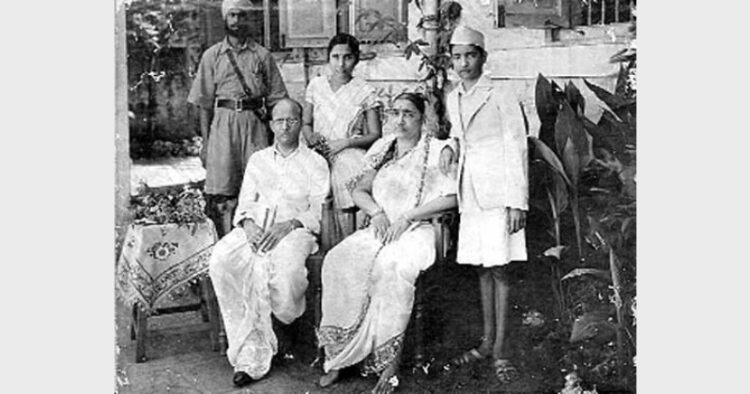Kid's Org ; A Jewel in the Galaxy
Children, whenever the topic of Freedom Struggle is raised only few names are projected before us. It is shown as if only because of these people our Bharat got freedom from the yoke of British Imperialism. However the credit for India's Independence goes to millions of people who came out to fight British rule and did not hesitate to give the supreme sacrifice to break the chains of bondage. It is unfortunate that many patriots who sacrificed everything for their motherland were forgotten in the pages of history. Had they lived their full life the destiny of Hindusthan would have been different. Veer Savarkar is one such person.
Vinayak Damodar Savarkar was born on May 28, 1883 into a family of jagirdars (landlords) in the Village of Bhagpur near Nasik. Vinayak was one of four children others being, Ganesh (Babarao), Mainabai and Narayan, born to Damodarpant Savarkar and Radhabai. He was looked after by elder brother Ganesh since his parents died when he was very young. Right from his childhood he was a prolific reader. He studied History of India from Vedic times and thoroughly read Sanskrit as well as English literature. Amongst other books, he was impressed by the biographies of Mazini, Garibaldi, Napoleon, Lenin and Trotsky etc. He read Bible, Koran and also the works of philosophers like Spencer, Mill, Darwin etc. and knew by heart half of Rabindranath Tagore's literature.
In 1898, the British hanged the Chapekar brothers in Pune for killing a British officer. This made a deep impact on the teenaged Savarkar, who decided to take up armed struggle against the British. Savarkar's patriotic spirit found an outlet through an organisation called the Mitra Mela that he formed. He inducted young patriotic men like himself into the Mela. He encouraged the members of the Mela to strive for “absolute political Independence for India”. Savarkar renamed the Mitra Mela as Abhinav Bharat and declared that “India must be independent; India must be united; India must be a republic; India must have a common language and common script.”
In March 1901, Savarkar was married to Yamunabai, daughter of Ramchandra Triambak Chiplunkar, who agreed to help Savarkar in his university education. After his matriculation examination, Savarkar got enrolled in Fergusson College in Poona in 1902.
|
In 1905, a huge Dussehra bonfire of foreign goods was lit in Poona by Savarkar and his friends to express resentment toward the Partition of Bengal. He left for London to study law in June 1906 on receiving a scholarship. Savarkar stayed at the India House in London. Savarkar founded the ‘Free India Society’ which held weekly meetings and celebrated Indian festivals and anniversaries of important figures.
In Britain, Savarkar organised students and advocated an armed struggle to throw the British out of India. Savarkar sent regular newsletters to India, wrote the book Joseph Mazzini in June 1907 and Indian War of Independence, 1857, in 1908. Since there was no question of printing the book in Britain, it was printed in Holland and copies of it were smuggled into India. The book was a huge success, giving Indians a strong sense of pride. In Britain, he also created a network of like-minded individuals. Seeing his anti-British activities, he was arrested in London on March 13, 1910 and sent to India to face trial.
While he was coming to India by a ship, the ship in which he was being taken to India berthed at Marseilles, France, on July 8, 1910. Savarkar wriggled out of the porthole and swam a great distance in the cold water to reach the shore, but the British recaptured him. He was tried, and on December 24, 1910, sentenced to 50 years in prison. On July 4, 1911, he was sent to Port Blair's Cellular Jail. Savarkar was sentenced to rigorous imprisonment and was placed in solitary confinement In 1920, Vithalbhai Patel—Vallabhbhai Patel's elder brother—demanded Savarkar's release, a demand also backed by Gandhi and Nehru. On May 2, 1921, Savarkar was shifted from the Cellular Jail, first to the Alipore Jail in Bengal and then to Ratnagiri Jail in western Maharashtra. While in Ratnagiri Jail, Savarkar wrote Hindutva which was smuggled out and published under the pen-name Maharatta. On his release, Savarkar founded the Ratnagiri Hindu Sabha on January 23, 1924 which aimed to preserve India's ancient culture and work for social welfare.
He was released on January 6, 1924 on the condition that he would not leave Ratnagiri District. He became active in the Hindu Mahasabha, founded in 1915, which sought to protect the interests of Hindus. Veer Savarkar founded the Ratnagiri Hindu Sabha on January 23, 1924 that aimed to preserve India’s ancient culture and work for social welfare. In 1937, he became president of the Hindu Mahasabha, and remained in the post till 1943. On August 15, 1947, Savarkar proudly unfurled the national flag along with the saffron flag of the Mahasabha. Savarkar agreed to join hands with the Congress in support of Gandhiji’s Quit India Movement on the condition that, “The Quit India Movement must not end in a Split India Movement”, he thundered on a BBC broadcast of his speech.
Savarkar who propounded the philosophy of Hindutva died on February 26, 1966 in Mumbai at the age of 83.
n Aniket Raja














Comments